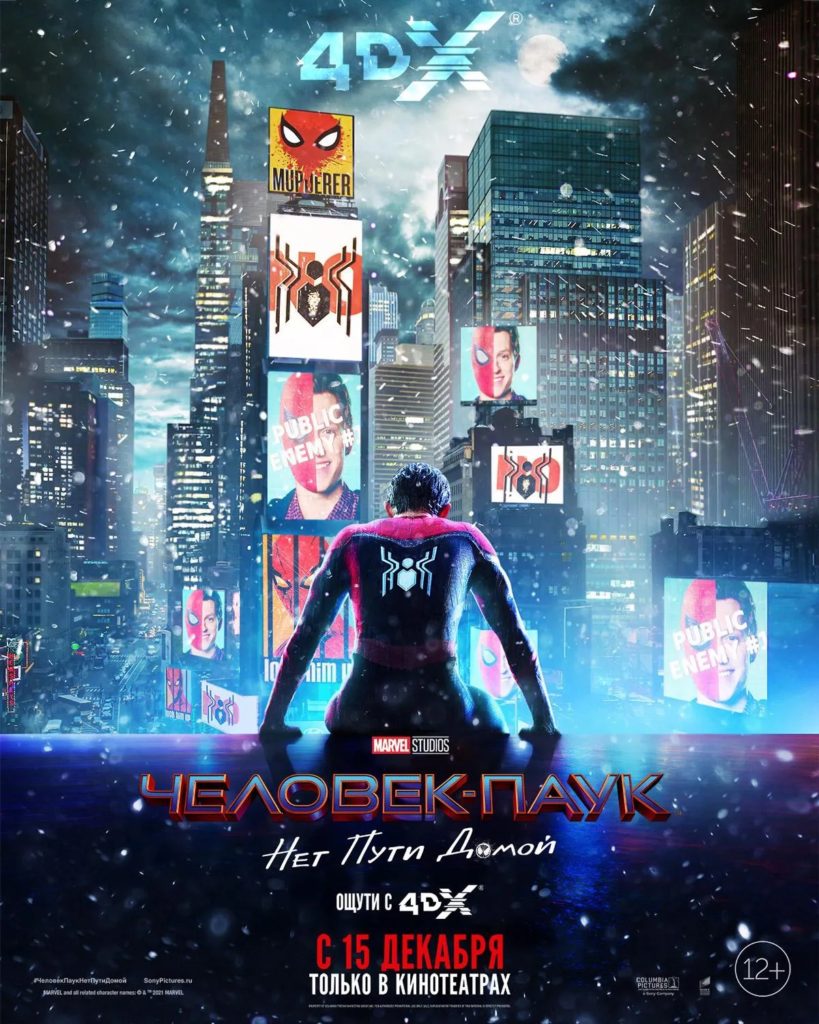山姆·雷米(Sam Raimi)的《蜘蛛侠》三部曲发行至今已有二十年了。2001年的时候,超级英雄类型电影还不是院线中的佼佼者。彼得·帕克(Peter Parker)、玛丽·简(Mary Jane)、他们的朋友和敌人等角色的起源故事以这样的电影风格呈现出来,真的会让人耳目一新。让你觉得“不能错过”,因为这样特别的影片不常见。
《蜘蛛侠》(2002)剧照
二十年后,蜘蛛侠三代更迭,每年以超级英雄为题的影视作品都在增加,你两只手都数不过来。可见漫威影视宇宙的策划非常成功,它轻松统治了流行文化的每个角落,压过了其他大型娱乐系列片,如《星球大战》或《哈利·波特》。而且,随着漫威宇宙的诞生,它自己的蜘蛛侠也应运而生,由汤姆·霍兰德(Tom Holland)扮演的蜘蛛侠有种孩子气的天真,他可以毫不费力地诠释彼得·帕克(Peter Parker)和他另一个蜘蛛侠身份。
三部曲的结局更为真诚的讲述了漫威最好的超级英雄这一神话:它在许多方面是漫威宇宙这一巨大机器的一个零件,但最重要的,它也是《蜘蛛侠》系列在屏幕上二十年来的的总结。
如今众多超级英雄电影的暴发让人们很难对这一类型的新片感到兴奋,《蜘蛛侠:英雄无归》是一次难得的出游,它会让你再次感受到“这是特别的,不要错过它”。
紧接着《蜘蛛侠:英雄远征》之后,反派昆汀·贝克(Quentin Beck)也就是神秘客(Mysterio)竟然将蜘蛛侠的身份公之于众,彼得必须直面身份暴露对他个人生活的种种负面影响。
他的女友MJ(Zendaya赞达亚饰演)和他最好的朋友Ned Leeds(Jacon Batalon雅各布·巴特朗饰演)都陪伴在他身边,但“出名”的黑暗面也随之而来。分身乏术,他求助于最高巫师斯蒂芬·斯特兰奇博士(Dr. Stephen Strange)。斯特兰奇告诉彼得,有个危险的咒语,他可以用这个咒语让全世界忘记他的身份。但因为彼得的性格,加上求成心切,咒语出现了问题。
这时导演乔·沃茨(Jon Watts)施以他自己的咒语,电影的魔术。彼得意图的失败让剧本更加精彩,这意味着彼得马上就要面对从多个平行宇宙和之前的《蜘蛛侠》电影中挑选出来的全新反派(多元宇宙的概念是漫威电影第四阶段的重点,在《复仇者联盟4:终局之战》之后发布)。
《蜘蛛侠:英雄无归》的故事,就在遗忘咒语的施展和完成之间展开。从三个不同维度(三个不同的《蜘蛛侠》系列电影)拉来众多反派一起加入很可能效果不佳,有四个反派的《蜘蛛侠3》(2007)就是活生生的证据,反面人物过多会导致情节混乱。但《蜘蛛侠:英雄无归》不仅仅是一份反派角色名单,你可以说三代集合是抢粉丝的钱,或者服务粉丝,但并不仅是如此。
这是一部特别的漫威电影,漫威时有人工操作,借力流行文化,以达到它自己的目的(比如把梁朝伟这样的银幕传奇人物加入到乱七八糟的《尚气与十环传奇》中,电影就正经了起来)。这次他们尝试用自己二十年的文化基因开辟新路径。
别的不说,漫威这二十年的持久力就是一段辉煌的历史,一个神话。这种神话对于漫威和DC这样的的公司并不那么难以成就,这些人物在漫画书里代代传承,他们不会衰老,如果不是非常必要的情况,也不会变化。这种永恒就是他们的吸引力。
在一部新电影中看到那些20年前的角色回归时,难免让人情绪激动,毕竟你以为那些角色已经成为过去。这就像你遇到一个学生时代结束后就没再见过的朋友,然后意识到他们现在已经长大了,也许添了一些智慧,但其实还是你曾经最关心的那个人。这的确是在服务粉丝,但很成功,由时间的积累而成,而不是随便露个脸。
《蜘蛛侠:英雄无归》有它的问题,视觉上它还是的充满无聊CGI的漫威电影。有些角色,比如赞达亚的MJ,为了给众多老角色让路而完全被边缘化了。一些演员的客串则倾向于廉价的粉丝服务,比如盲人律师马特·默多克(Matt Murdock),也就是夜魔侠(Daredevil)出场代理彼得·帕克(这也太漫画了,彼得需要律师嘛?我们必须加入律师角色?)。
尽管这部电影有表面上的缺陷,但故事情节表达充分,最重要的是完成了彼得·帕克(Peter Parker)的人物弧。在紧张激烈的三部曲终章,很容易脱离对主人公的塑造,但剧本始终关注着主人公。在《蜘蛛侠:英雄归来》的开头,彼得·帕克是一个总是很兴奋的高中生,在《蜘蛛侠:英雄无归》最后,他已经是个一个独立的年轻人了。
《蜘蛛侠:英雄无归》的成功证明:在过去的20年里,漫威通过银幕和观众创造了个人情感的连结,并在多年间不断积累加强,尤其是那些从起点就一路随行的粉丝们。
聪明的是,它没有把粉丝的青睐和支持浪费在一两个廉价的客串上,但它也没有过分倚重那些老电影的遗产而疏忽它的新英雄。通过精心计算,本片得以平衡两方,结果出人意料的令人满意,并和影迷产生长久的共鸣,票房数字、观众评分以及压倒性的好评都证明了这一点。
赫兰德在《蜘蛛侠》三部曲的终曲中证明了蜘蛛侠有他自己的联盟,属于漫威电影宇宙,但不依赖于它,也具有作为一般电影艺术的普遍吸引力。这可能是仅仅是漫威无尽宇宙的一部分,但实际上它是八部《蜘蛛侠》电影宇宙的最后一块拼图,这块拼图从2001年开始,不断拼凑,现在终于有了完整的样子。

影评人简介
贝尔纳多·莱特(Bernardo Leyte),常驻巴黎的电影制作人。 他在西班牙、德国和英国长大,毕业于伦敦电影学院,目前担任导演。 他是一位充满热情的影迷,他所观看的电影囊括各种类型,从他的偶像斯坦利·库布里克(Stanley Kubrick)和安德烈·塔可夫斯基(Andrei Tarkovsky)的電影,到超级英雄、恐怖片、动漫等。

Spiderman: No Way Home Review
It’s been twenty years since Sam Raimi’s Spiderman trilogy was released. Back in 2001, superhero films were far from the only kind of mass entertainment available in cinema, and seeing the origin story of Peter Parker, Mary Jane, their friends and foes brought to life with such filmmaking style and heart felt very special. It was a feeling of “don’t miss it”, because it could very well be the last time. Two decades and three different incarnations of Spiderman later, there are more superhero films and television shows every year than you can count on the fingers of two hands. The Marvel Cinematic Universe has proven to be a hugely successful enterprise which easily dominates every corner of pop culture, ruling supreme over other titans of mass entertainment like Star Wars or Harry Potter. And, with the MCU came its own Spider-Man, played with boyish naiveté by the talented Tom Holland, who can effortlessly fill the shoes of both Peter Parker and his web-slinging alter ego. This conclusion of his own trilogy is a heartfelt addition to the mythology of Marvel’s best superhero; part of the Marvel Machine in many ways, but most importantly a culmination of twenty years of Spiderman legacy on screen. And, although the availability of superhero films makes it difficult to feel excited about any new release in the genre, Spiderman: No Way Home is a rare outing where the feeling of “this is special, don’t miss it” comes back in a big way.
In the wake of Spiderman: Far from Home, in which the villainous Quentin Beck a.k.a Mysterio shockingly told the whole world the identity of Spiderman, Peter is dealing with this revelation’s negative repercussions to his personal life. He still has his girlfriend MJ (Zendaya) and his best friend Ned Leeds (Jacon Batalon) by his side, but the dark side of celebrity does not take long to show its teeth. Unable to cope, he turns to none other than the Sorcerer Supreme, Dr. Stephen Strange, for help. With the help of a dangerous spell, Strange tells Peter that he can make the whole world forget about his identity. Due to Peter’s characteristic over-eager attitude, the spell goes wrong, which is where director Jon Watts begins his own conjuration, one of movie magic, where the spell follows the rules of script convenience, which means that Peter is immediately faced with a whole new collection of villains pulled from multiple parallel universes and previous Spider-Man films (the idea of the multiverse is the main attraction of Marvel’s Phase Four of films that are being released after Avengers:Endgame).
It is in this interstitial space between the casting of this oblivion spell and its completion that Spiderman: No Way Home lives. This playground of multiple foes pulled from three different dimensions (three different franchises) would usually be a recipe for disaster: the overstuffed Spiderman 3 (2007), with four villains, seemed to be living proof that too many antagonists can muddle a plot. But something far more interesting than a large gallery of villains is being done in No Way Home. The dark side of bringing together these three generations could be called a cash-grab, or simply fan service, and it is unmistakably that too, but it’s more. This is a different kind of Marvel film because, where the company sometimes manipulates its power in pop culture to get what they want immediately and artificially (such as placing a screen legend like Tony Leung in the messy Shang-Chi film to lend it some gravitas), this time they are using their own twenty year cultural DNA to create something unique.
If nothing else, Marvel’ staying power over two decades has earned the company a history, a mythology. This mythology exists in the comic book universes of companies like Marvel and DC quite easily; the characters have existed on the page for generations and they do not age, or change more than strictly necessary. Their own immutability is their attraction. But seeing the characters of twenty years ago come back in a new film when you thought they were long gone, a thing of the past, can be a powerful, sometimes emotional experience. It’s like running into a friend that you haven’t seen since your school days and realising that they are now older, maybe a little bit wiser, but fundamentally the same person you once cared about. This is indeed fan service, but it is fan service done right, earned by the passing of time itself and not wasted on a cheap cameo appearance.
Spiderman: No Way Home has its problems, and visually doesn’t deviate from the boring Marvel CGI pre-fabricated cinematography. Some characters, like Zendaya’s MJ, are completely sidelined to make way for the avalanche of older characters that pop into this universe. Some cameos are indeed leaning towards the cheap fan service side of the spectrum, such as Matt Murdock aka Daredevil, the blind lawyer, showing up to represent Peter Parker (although this is also a very comic-book thing: Peter needs a lawyer? What lawyer character do we have to throw in there?). Despite the film’s surface flaws, it accomplishes its main storyline admirably, especially keeping sight of what is most important, which is to finish the character arch of Tom Holland’s Peter Parker. It would have been easy to lose track of him in the midst of the explosive final third film, but the script stays with its protagonist throughout. At the beginning of Spiderman: Homecoming, Peter Parker was an over-excited high schooler. By the end of No Way Home, he is an independent young man.
Spiderman: No Way Homeproves that Marvel’s presence in our screens for the last twenty years has created a reserve of emotional and personal connection for those fans who have been along for the ride since the beginning. Intelligently, the doesn’t waste this reservoir of goodwill on a cheap guest appearance or two, but it doesn’t lean so heavily on the legacy of those older films that it forgets about it new hero. By striking a well-calculated balance, this is an incredibly satisfying film that will resonate with fans for a very long time, as evidenced by the box office numbers and the viewer ratings, as well as the overwhelmingly positive critical reception. This trilogy capper of Holland’s run also proves that Spider-Man is in a league of his own, a part of Marvel but not beholden to the cinematic universe in order to achieve its universal appeal. This may be part of the endless Marvel Cinematic Universe, but in reality it is the last piece of the puzzle of the eight-film Spiderman Cinematic Universe, a puzzle that was started in 2001 and, after some ups and downs, now finally feels complete.

About the Author
Bernardo Leyte (Vigo, Spain) is a Paris-based filmmaker. He grew up in Spain, Germany and the UK, graduating as a director from the London Film School. He is a passionate cinephile whose eclectic film playlist includes a bit of everything, from his idols, Kubrick and Tarkovsky, to superheroes, horror, anime and everything in between.

